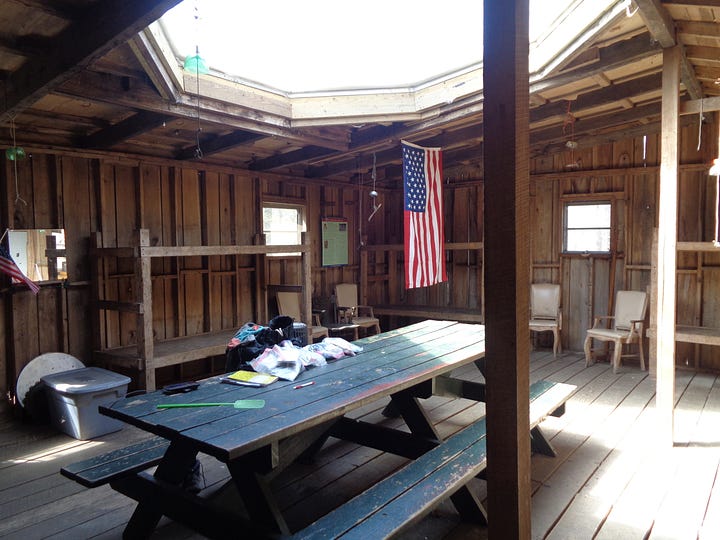#162 Stealth Campsite to 501 Shelter - Day 87 -MM1184.0 - MM1196.1
The 501 Shelter looks more like a bunkhouse at a boy scout camp than an Appalachian Trial shelter.
4-13-2023
Birds songs I’ve never heard before awaken me. The farther north I travel the more new songs I’ll hear.
Last night was warm. I started out on top of the sleeping bag, but climbed inside it at some point during the night. I don’t even remember it.
That cracking sound last night, when I threw the bag to hang it, was my plastic bowls. I duct tape them up. It worked fine for the thickness of oatmeal but not for the thinness of coffee so I put one cup inside the other and that worked - so long as I drank the coffee as fast as possible.
I leave camp early in order to beat the heat to the next mountain’s climb, stopping only to gather water three minutes into the hike.
I cross Hwy 81, The Waterville Bridge over Swatara Creek, where I’m greeted by a middle aged man on an old bicycle heading into work by way of the Bear Hole Trail Greenway.
Heat and humidity labor my breathing. Rocks slow me down considerably up the steep and steady incline- but slow and steady wins the race.
The heat and the rocky trail give way to more heat and an old dirt road.
William Penn Shelter looks to me like like could tip over and roll off the mountain in the first decent wind. It stands on the ridge towering over the beautiful valley below with its top-heavy ice-cream cone shaped design. Yellow jackets swarm the area but don’t seem interested in a fight.
A trail runner drops in to look at the shelter - he’s never seen a real Appalachian Trail shelter before.


He and I leave together. He is running in the same direction I’m walking which means that this section of trail, at least for a while, should be more manageable to walk. I’m curious about this two-track dirt road across the spine of this mountain the Appalachian Trail traces. Now mainly used for recreation. Historically, the land was used to supply charcoal to the Camp Strauss iron works. The owner at the time timbered the area in 1917 and 1918. Lumber was hauled out by narrow gauge railroad to Innwood and Meckville. Water was provided to the ironworks by a dam at Camp Strauss. - Wikipedia
I bet moonshiners ran through here, but I couldn’t find history on that, I really wanted to read stories about that.
The sun blazes down through the bare trees and exposed ridgeline. My shirt came off a long time ago and my shoulders are turning pink. My hike for the day is soon coming to an end.
Verbal directions from people in small towns may sound like this, “Head down Elm Street ‘til you reach the old brick furniture store that went out of bid’niz several years ago, darn shame too, that’s were you wanna take your left, then follow the row of old houses about a mile, be sure to wave at Edna on the porch as you drive by, she’s always there, bless her heart, - you’ll run right into it.”
On this mountain today it would go like this, ”Hike the rocky trail below the blazing sun on an unreasonable, unseasonably warm day until you reach the graffiti infested rocks, that’s where the trail makes a sharp turn left, turn away from the dusty ridge and follow the trail across the two-lane 501 Highway, be sure to wave at the couple getting high near the parking lot as you hike by, they’re always there, bless their hearts, then follow the blue blaze trail towards the 501 Shelter - you’ll run right into it.”
I am the first to arrive. The 501 Shelter looks more like a bunkhouse at a boy scout camp than an Appalachian Trial shelter. It has four walls, windows that are already cranked open, wooden bunks with no mattresses, a wooden floor, a little library (registered), an American flag, a long picnic table, an octagon skylight, chairs, and board games.




*Subscribe now to finish reading this post - $5.00 Monthly / $50.00 Yearly.





